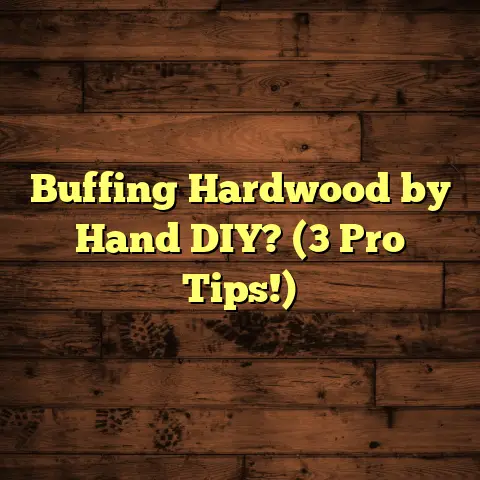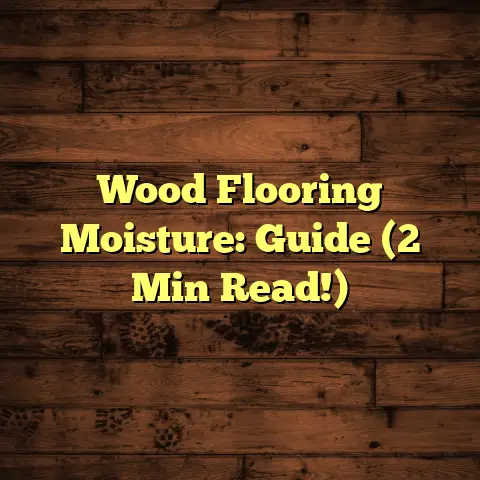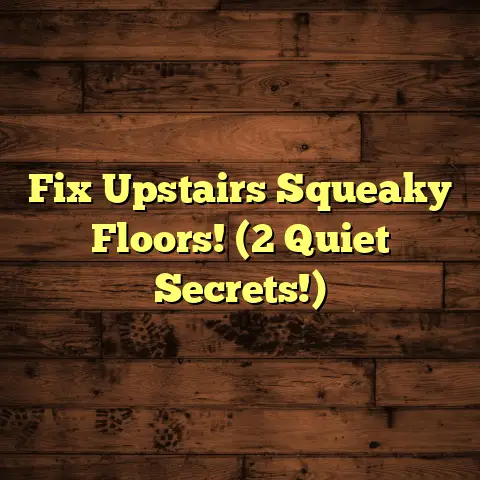Curb Appeal: Flooring’s Role (3 Secrets Revealed!)
The myth? “Flooring only matters indoors.”
Seriously?
Let’s ditch that idea right now!
Flooring is a HUGE player in your home’s curb appeal, and I’m going to show you why.
Think of it this way: the outside of your house is the handshake, and the inside is the conversation.
You want that handshake to be firm, friendly, and memorable, right?
That’s where the right flooring choices come in.
It’s about making your property more inviting and, yes, even increasing its value.
Ready to dive in and unlock the secrets? Let’s go!
The Importance of First Impressions
Have you ever driven past a house and instantly thought, “Wow, I love that place!”?
That’s curb appeal working its magic.
It’s the instant connection people make when they see your home for the first time.
And guess what?
That first impression is powerful stuff.
Did you know?
A study by the National Association of Realtors (NAR) found that 49% of buyers were influenced by curb appeal when deciding on a home. (Source: 2020 Remodeling Impact Report, NAR)
That’s almost half of all buyers!
Curb appeal can influence perceptions of property value.
A well-maintained exterior, including beautiful flooring, can lead potential buyers (or even just visitors) to believe that the inside is equally well-cared for.
Think about pathways, patios, and decks.
These are all opportunities to make a statement with your flooring choices.
They set the stage for what’s inside and create a welcoming vibe.
So, let’s get down to the secrets of choosing the right flooring to boost your curb appeal.
Secret #1 – Choosing the Right Material
Okay, so you’re on board with the idea that outdoor flooring matters.
Great! Now, what material should you use?
There are tons of options, and each has its pros and cons.
Let’s break down some of the most popular choices:
-
Wood: Ah, the classic. Wood decks and porches have a timeless appeal.
- Pros: Beautiful, natural look; comfortable underfoot.
- Cons: Requires regular maintenance (staining, sealing); prone to rot and insect damage if not properly treated; can be expensive.
- Best For: Homes with a traditional or rustic style.
-
Composite: This is a mix of wood fibers and plastic.
- Pros: Low maintenance; resistant to rot, insects, and fading; long-lasting.
- Cons: Can look less natural than wood; can get hot in direct sunlight; generally more expensive than wood upfront but cheaper long term.
- Best For: Homeowners who want the look of wood without the hassle.
-
Stone: Think flagstone, slate, or even gravel.
- Pros: Durable; natural; adds texture and visual interest; can be relatively low-maintenance.
- Cons: Can be slippery when wet; some types can be expensive; installation can be labor-intensive.
- Best For: Homes with a natural or earthy aesthetic.
-
Tile: Porcelain or other outdoor-rated tiles are great for patios and walkways.
- Pros: Durable; water-resistant; easy to clean; lots of design options.
- Cons: Can be slippery when wet; can crack in freezing temperatures if not properly installed; can be expensive.
- Best For: Homes with a modern or Mediterranean style.
-
Concrete: A versatile and budget-friendly option.
- Pros: Durable; low maintenance; can be stained, stamped, or textured for a custom look.
- Cons: Can be plain if not treated; can crack over time; can get hot in direct sunlight.
- Best For: Homes with a contemporary or minimalist style.
My Experience:
I once worked on a project where the homeowners wanted a natural stone patio that would blend seamlessly with their existing landscaping.
We chose flagstone in varying sizes and colors, and the result was stunning.
It looked like it had been there forever!
But here’s the thing: the key is to consider your home’s style and landscaping.
A sleek, modern house might look great with a concrete patio, while a charming cottage would be better suited to a wood deck or stone pathway.
Consider this:
Think about the colors, textures, and materials already present in your home’s exterior.
Choose flooring that complements these elements, not clashes with them.
Pro Tip:
Before making a decision, get samples of different materials and see how they look in your space.
Hold them up against your house, look at them in different lighting conditions, and imagine how they’ll look with your landscaping.
Secret #2 – Designing for Harmony
Okay, you’ve picked your material. Now it’s time to think about design.
This is where things can get really fun (or really disastrous if you’re not careful!).
Color schemes and patterns can make or break your curb appeal.
Color Considerations:
- Complementary Colors: These are colors that are opposite each other on the color wheel (e.g., blue and orange, red and green). They create a vibrant and eye-catching contrast.
- Analogous Colors: These are colors that are next to each other on the color wheel (e.g., blue, blue-green, and green). They create a harmonious and soothing effect.
- Neutral Colors: These are colors like white, gray, beige, and brown. They’re versatile and can be used to create a clean and sophisticated look.
Pattern Play:
The pattern of your flooring can also have a big impact.
A simple, repeating pattern can create a sense of order and calm, while a more complex pattern can add visual interest and personality.
- Herringbone: A classic pattern that adds a touch of elegance.
- Basketweave: A simple and versatile pattern that works well with many different styles.
- Random: A more informal pattern that can create a natural and organic look.
Visual Flow:
One of the most important things to consider is the visual flow between your indoor and outdoor spaces.
You want the transition to be seamless and natural.
Here’s an example:
If you have hardwood floors inside, consider using a similar wood tone for your deck or porch.
Or, if you have tile floors inside, you could use a matching or complementary tile for your patio.
My Mistake (So You Don’t Make It):
I once worked on a project where the homeowners insisted on using a bright red brick for their patio, even though their house was painted a pale yellow.
The result was… jarring.
The colors clashed horribly, and the patio looked completely out of place.
We ended up having to redo the entire thing with a more neutral-toned paver.
Lesson learned:
Don’t be afraid to take risks with color and pattern, but always consider the overall aesthetic of your home.
Tips for Coordinating Indoor and Outdoor Styles:
- Use a consistent color palette: Choose a few key colors and use them throughout your home, both inside and out.
- Repeat patterns: If you have a certain pattern in your indoor flooring, try to incorporate it into your outdoor flooring as well.
- Use similar materials: If you have hardwood floors inside, consider using a wood deck or porch.
- Pay attention to details: Small details like trim, lighting, and hardware can make a big difference in creating a cohesive look.
Secret #3 – Creative Uses of Flooring in Landscaping
Okay, now let’s get creative!
Flooring isn’t just for patios and walkways.
It can be used in all sorts of innovative ways to enhance your landscaping and create unique outdoor spaces.
Patios:
The classic outdoor living space.
Patios are perfect for relaxing, entertaining, and enjoying the outdoors.
You can create a patio with just about any type of flooring, from concrete to stone to tile.
Walkways:
Guide visitors through your property and add visual interest to your landscaping.
Walkways can be made from a variety of materials, including pavers, gravel, and stepping stones.
Outdoor Living Areas:
Create an extension of your indoor living space by adding a kitchen, dining area, or lounge area to your backyard.
Outdoor living areas can be as simple or as elaborate as you like.
Case Study: The Secret Garden:
I once worked on a project where the homeowners wanted to create a “secret garden” in their backyard.
We used a combination of stone pathways, gravel beds, and wooden decks to create a series of interconnected spaces.
The result was magical.
It felt like you were stepping into another world.
Defining Spaces:
Flooring can be used to define different areas within your landscape.
For example, you could use a different type of flooring to create a separate dining area or a play area for kids.
Creating Focal Points:
Use flooring to draw attention to specific features in your landscape, such as a fountain, a sculpture, or a beautiful tree.
Guiding Visitors:
Use pathways to guide visitors through your property and highlight key features.
My Favorite Trick:
I love using stepping stones to create a whimsical and inviting pathway through a garden.
It’s a simple way to add a touch of magic to any landscape.
Here are some additional ideas for incorporating flooring into your landscaping:
- Create a fire pit area with a circular stone patio.
- Build a raised garden bed with a wooden frame.
- Install a water feature with a tiled base.
- Add a pergola with a paved floor.
Remember:
The key is to think outside the box and experiment with different materials and designs.
Don’t be afraid to get creative and have fun!
Conclusion
So, there you have it: the three secrets to using flooring to enhance your curb appeal.
Let’s recap:
- Choose the right material: Consider your home’s style, your budget, and your maintenance preferences.
- Design for harmony: Pay attention to color schemes, patterns, and visual flow.
- Get creative with landscaping: Use flooring to define spaces, create focal points, and guide visitors.
I hope this article has inspired you to rethink your outdoor flooring choices.
These decisions can significantly impact your home’s first impression and overall value.
Don’t underestimate the power of a well-designed and well-maintained exterior.
It’s the first thing people see, and it can make all the difference in the world.
Now, go out there and create some curb appeal magic!
If you have any questions or need help with your flooring project, don’t hesitate to reach out.
I’m always happy to help.
Happy flooring!





